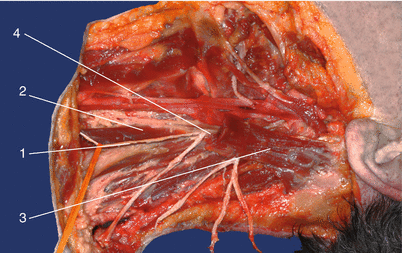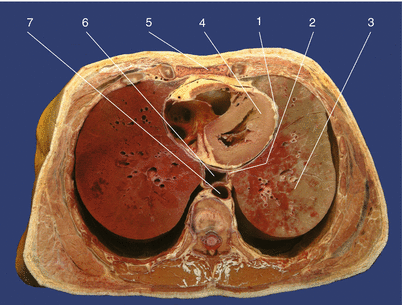Fig. 9.1
Anatomy. (1) Phrenic nerve, (2) scalenus anterior, (3) cervical plexus (C3, C4), (4) brachial plexus, (5) vagus nerve, (6) internal carotid artery (With permission from Danilo Jankovic)

Fig. 9.2
Anatomic specimen. (1) Phrenic nerve, (2) scalenus anterior, (3) sternocleidomastoid (partly resected), (4) deep cervical plexus (C4). The course of the phrenic nerve on the scalenus anterior is regarded as a landmark zone (With permission from Danilo Jankovic)
The nerve then passes through the mediastinum as far as the diaphragm, giving off fine branches—the pericardiac branches—along the way, to provide the sensory supply to the pericardium (Fig. 9.3). On the surface of the diaphragm, it divides and supplies the entire diaphragmatic musculature. Fine branches provide the sensory supply to the skin adjoining the diaphragm, to the pleura cranially, and caudally to the diaphragmatic peritoneum and the peritoneal coat of the upper abdominal organs.


Fig. 9.3
Transverse section through the chest at the level of T9. (1) Left phrenic nerve, (2) vagus nerve, (3) lung, (4) left ventricle, (5) sternum, (6) esophagus, (7) aorta (With permission from Danilo Jankovic)
When the nerve is paralyzed unilaterally, pulmonary capacity declines by approximately 200–500 mL or 400–600 mL. At resting respiration, this represents 37–48 %.
Indications
1.
Treatment-resistant hiccup of various etiologies (after exclusion of central causes and nonresponse to drug therapy). Treatment-resistant hiccup can have numerous causes [5]
Idiopathic
Psychogenic
Organic
Central nervous system (neoplasms, multiple sclerosis, cerebrovascular insults, trauma)
Peripheral nervous system (irritation of the phrenic nerve or vagus nerve)—tumors (stomach, pancreas, lung)
Renal causes (uremia) or hepatic diseases
Pericarditis
Tumors in the head and neck area
Hiatus hernia
Drug–induced/metabolic:
Intravenous administration of glucocorticoids, general anesthesia, administration of pethidine (Dolantin®), pentazocine (Fortral®)
Infections (sepsis, malaria, tuberculosis)
Electrolyte imbalance (hypocalcemia, hyponatremia)
2.



Pain in the innervation area (e.g., caused by tumors in the lung, mediastinum, or diaphragm or by metastases). Signs of irritation of the phrenic nerve include epigastric pain radiating into the shoulder area.

Full access? Get Clinical Tree








